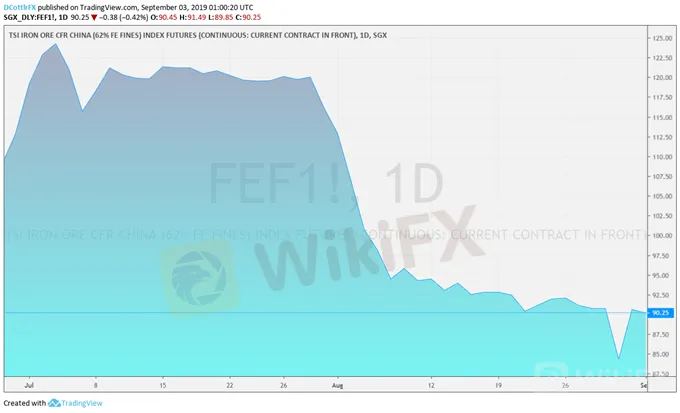简体中文
繁體中文
English
Pусский
日本語
ภาษาไทย
Tiếng Việt
Bahasa Indonesia
Español
हिन्दी
Filippiiniläinen
Français
Deutsch
Português
Türkçe
한국어
العربية
Iron Ore Prices Slide On Trade War Fears, AUD-Watchers Take Note
Abstract:Australian Dollar watchers should keep a close eye on iron ore prices. They fell sharply last month, albeit from very high levels
Australian Dollar, Iron Ore Talking Points:
Iron ore prices had a bad August
Question marks loom over demand as supply is growing again
Australian Dollar traders should watch where prices and export levels go
What do retail foreign exchange traders make of your favorite currencys chances right now at the DailyFX Sentiment Page
The Australian Dollar is close to eleven-year lows against its big US brother and the market probably didnt need another reason to be bearish on the currency. It might have got one last month though as iron-ore prices took a massive hit.
According to the IODEX measure from Platts which indicated the spot price paid for most of the ore delivered to China, prices were down 27% through August. The commodity is Australia‘s major raw material export, among many. But a world worried about recession and trade war clearly isn’t going to need as much of it.

It‘s worth pointing out that iron ore prices have been highly volatile this year. January’s lethal damn-burst disaster in Brazil saw supply from that quarter limited and drove prices up some 75% on the year to July‘s peak. This rise may have slowed AUDUSD’s decline this year. Australia also saw a very steady rise in exports into June, when they hit record levels, as markets increasingly looked to the country for supplies. Still, the market appears to be rebalancing and, with prices falling, Aussie Dollar traders would do well to keep a close eye on where it goes from here.
Supply Crunches Elsewhere Have Boosted Australian Ore Exports
Iron ore exports ran at around A$9 billion (US$6 billion) per month in May and June, so the potential effect on the Australian Dollar is clear. Those months look to have been outliers, though, with somewhere between A$4 and A$6 billion far more usual. A return to those sorts of levels might well weigh on the currency. There has been better news for Australia in other parts of the commodity complex, too. Nickel prices have gained, for example, thanks to a proposed export ban in Indonesia. However Australian nickel exports are worth only a fraction of its iron ore earnings.
Australian Dollar trade is often seen as a function of huge global themes. The currency can at times act as a liquid China-market proxy, or a as a proxy for overall risk appetite, so tied can it seem to the global cycle. This has clearly weighed on AUDUSD this year, as has the relentlessly lower path of Australian interest rates.
They‘re now at a new record low of 1% and the markets think they’ll hit 0.5% by the middle of next year.
But amid all those themes there‘s Australia’s real economy, and iron ore exports are about as real is it gets.
Whether we see more volatility or an extension of Augusts falls, Aussie Dollar traders need to know.
Australian Dollar Resources for Traders
Disclaimer:
The views in this article only represent the author's personal views, and do not constitute investment advice on this platform. This platform does not guarantee the accuracy, completeness and timeliness of the information in the article, and will not be liable for any loss caused by the use of or reliance on the information in the article.
Read more

All Round Major Pairs Technical Analysis: EUR/USD, AUDUSD, And GBPUSD
The start of November has been a dwindling moment for the general major currency market. As essential economic updates flood the surface of the entire foreign exchange market, in which most of the currency pairs especially the major pairs were greatly affected by the impact of the economic releases. However, the US dollar was discovered to have held the main currency exchange performance metrics as the central economic updates from the US region tend to have determined the significant changes that have occurred in the major currency market so far.

Currencies wait for RBA to kick off big central bank week
The dollar hovered below recent highs on Tuesday as traders waited for the Reserve Bank of Australia to lead a handful of central bank meetings set to define the rates outlook this week.

US Dollar Holds Gains as Japan Boosts and China PMI Weighs. USD Volatility Ahead?
US DOLLAR, JAPAN ELECTION, USD/JPY, CHINA PMI, AUD/USD - TALKING POINTS

Australian Dollar Price Chart: AUD/USD Reversal Stalls– Trade Outlook
The Australian Dollar is up more than 2.6% on the back of a five-day rally with price eyeing initial resistance. These are the levels that matter on the AUD/USD charts.
WikiFX Broker
Latest News
BI Apprehends Japanese Scam Leader in Manila
Bitcoin in 2025: The Opportunities and Challenges Ahead
Join the Event & Level Up Your Forex Journey
Is There Still Opportunity as Gold Reaches 4-Week High?
Bitcoin miner\s claim to recover £600m in Newport tip thrown out
Good News Malaysia: Ready for 5% GDP Growth in 2025!
How to Automate Forex and Crypto Trading for Better Profits
Breaking News! Federal Reserve Slows Down Interest Rate Cuts
Beware: Pig Butchering Scam Targeting Vulnerable Individuals
This Economic Indicator Sparks Speculation of a Japan Rate Hike!
Currency Calculator






